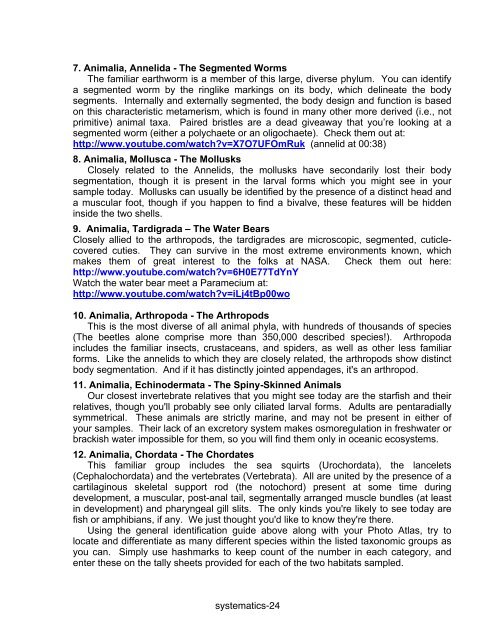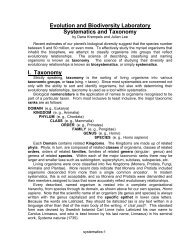Evolution and Biodiversity Laboratory Systematics and Taxonomy
Evolution and Biodiversity Laboratory Systematics and Taxonomy
Evolution and Biodiversity Laboratory Systematics and Taxonomy
Create successful ePaper yourself
Turn your PDF publications into a flip-book with our unique Google optimized e-Paper software.
7. Animalia, Annelida - The Segmented WormsThe familiar earthworm is a member of this large, diverse phylum. You can identifya segmented worm by the ringlike markings on its body, which delineate the bodysegments. Internally <strong>and</strong> externally segmented, the body design <strong>and</strong> function is basedon this characteristic metamerism, which is found in many other more derived (i.e., notprimitive) animal taxa. Paired bristles are a dead giveaway that you’re looking at asegmented worm (either a polychaete or an oligochaete). Check them out at:http://www.youtube.com/watch?v=X7O7UFOmRuk (annelid at 00:38)8. Animalia, Mollusca - The MollusksClosely related to the Annelids, the mollusks have secondarily lost their bodysegmentation, though it is present in the larval forms which you might see in yoursample today. Mollusks can usually be identified by the presence of a distinct head <strong>and</strong>a muscular foot, though if you happen to find a bivalve, these features will be hiddeninside the two shells.9. Animalia, Tardigrada – The Water BearsClosely allied to the arthropods, the tardigrades are microscopic, segmented, cuticlecoveredcuties. They can survive in the most extreme environments known, whichmakes them of great interest to the folks at NASA. Check them out here:http://www.youtube.com/watch?v=6H0E77TdYnYWatch the water bear meet a Paramecium at:http://www.youtube.com/watch?v=iLj4tBp00wo10. Animalia, Arthropoda - The ArthropodsThis is the most diverse of all animal phyla, with hundreds of thous<strong>and</strong>s of species(The beetles alone comprise more than 350,000 described species!). Arthropodaincludes the familiar insects, crustaceans, <strong>and</strong> spiders, as well as other less familiarforms. Like the annelids to which they are closely related, the arthropods show distinctbody segmentation. And if it has distinctly jointed appendages, it's an arthropod.11. Animalia, Echinodermata - The Spiny-Skinned AnimalsOur closest invertebrate relatives that you might see today are the starfish <strong>and</strong> theirrelatives, though you'll probably see only ciliated larval forms. Adults are pentaradiallysymmetrical. These animals are strictly marine, <strong>and</strong> may not be present in either ofyour samples. Their lack of an excretory system makes osmoregulation in freshwater orbrackish water impossible for them, so you will find them only in oceanic ecosystems.12. Animalia, Chordata - The ChordatesThis familiar group includes the sea squirts (Urochordata), the lancelets(Cephalochordata) <strong>and</strong> the vertebrates (Vertebrata). All are united by the presence of acartilaginous skeletal support rod (the notochord) present at some time duringdevelopment, a muscular, post-anal tail, segmentally arranged muscle bundles (at leastin development) <strong>and</strong> pharyngeal gill slits. The only kinds you're likely to see today arefish or amphibians, if any. We just thought you'd like to know they're there.Using the general identification guide above along with your Photo Atlas, try tolocate <strong>and</strong> differentiate as many different species within the listed taxonomic groups asyou can. Simply use hashmarks to keep count of the number in each category, <strong>and</strong>enter these on the tally sheets provided for each of the two habitats sampled.systematics-24

















